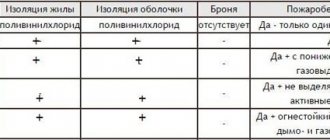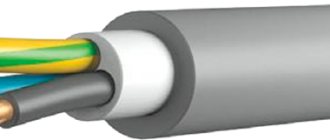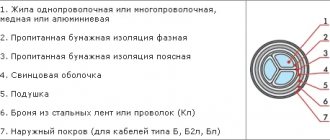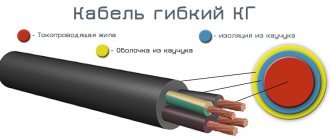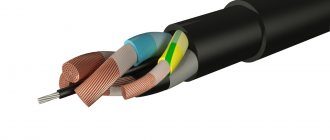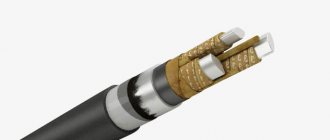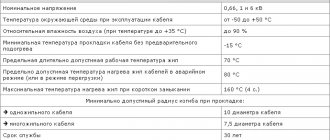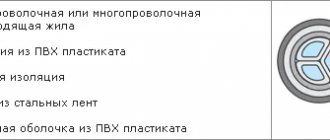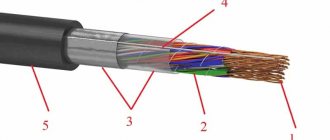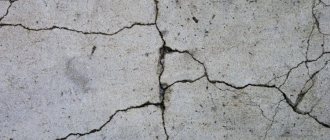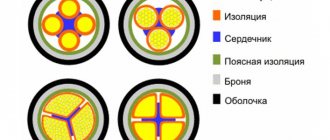To transmit electricity over distances, along with overhead lines, power cables are widely used. As for the power supply to consumers located in industrial buildings, as well as electrical wiring in residential buildings, insulated wires and cable lines are widely used for these purposes. One of the most successful types of such wires, which is widely used in electrical networks, is the VVG cable.
In general, a power cable is an electrical conductor of large cross-section with one or more cores. Each such core is covered with a layer of insulation, in addition, they are all enclosed in a protective sheath. Also, some models may use protective screens or armor to improve their performance.
During operation, power cables pass very large currents through themselves, so the insulation of their individual current-carrying cores from each other and from the external environment is carried out in compliance with the highest reliability requirements.
The transmission and distribution of electricity in low-power household electrical networks is carried out using copper and aluminum electrical wires, which are significantly inferior to power cables in reliability and power, but are more compact, easy to use and cheaper.
Characteristics of VVG cables
It is advisable to begin the description of such products by deciphering their abbreviations. Let's consider it using the example of a VVG 2x4 cable. Decoding of VVG cable:
- the first letter “B” corresponds to PVC insulation of cable cores,
- the second “B” is PVC insulation shell,
- the letter "G" means the absence of protective coverings,
- and the numbers 2x4 indicate the number of cores and their cross-section, respectively.
The maximum temperature at which long-term use of VVG brand wires is permissible is +50 C0, the minimum is –50 C0. In this case, the maximum possible temperature of their heating during overload can reach +80 C0, and in the event of a short circuit current flowing for no more than 4 s, it is allowed to increase to +160 C0.
Let's continue to get acquainted with the technical characteristics of the VVG cable; it has several (from one to 5) separate copper cores that are covered with insulation. If the number of such conductors is more than 2, then they may all have the same diameter, or one of the conductors, intended for the neutral or ground wire, may have a slightly smaller cross-section.
Polyvinyl chloride plastic compound, or PVC for short, is used as an insulation material in the manufacture of VVG cables. This material is a type of plastic that is characterized by high dielectric properties, resistance to aggressive chemicals and low flammability. There are cable models whose insulation is made of PVC plastic compound, which has improved properties:
- Reduced flammability (VVGng).
- Reduced smoke and gas emissions.
USEFUL INFORMATION: How to properly glue wallpaper (video)
Cores can be produced in solid (single-wire) and multi-wire versions. In addition, there are VVG cables with round and sector (segment) sections of copper conductors.
The cross-section of each individual core depends on their purpose and the power of the consumers being fed. The VVG line of cables includes models with core cross-sections ranging from 1.5 to 240 mm2. Depending on the diameter and number of cores, the weight of the VVG cable varies.
Depending on the functional purpose, required cross-section and installation location, VVG cables of various diameters, made in different versions: flat, non-flammable, etc. can be used.
There are such options for their marking:
- VVG. A universal option.
- AVVG. With aluminum conductors.
- VVGng. Incombustible.
- VVG-P and VVGng-P. Flat and, accordingly, non-flammable flat.
- VVGz. Filled. This means that there is an additional dielectric filler between the insulated cores.
When laying any cable line, there is a need for bends and turns of current-carrying wires. In order to ensure maximum reliability and durability of such an electrical network, it is necessary to adhere to clearly defined requirements for the maximum bending radius of its conductors. For the VVG brand, this parameter ranges from 7.5 to 15 of its diameters.
Types, types
VVG is described by GOST 16442-80. The division into types and markings are given in the table. The type determines the presence of plastic modifiers that improve fire resistance and prevent the spread of fire in the wire insulation.
| Sign | Description | Marking symbol |
| Core material | Copper | Without designation |
| Aluminum | A | |
| Insulation material | Polyvinyl chloride | IN |
| Shell material | Same | IN |
| Availability and type of armor | Absent | G |
| Cross-sectional shape | Round | Without designation |
| Flat | P | |
| Availability of filler | Filling the space between insulation and sheath | Letter "z" |
| When laid in groups, does not spread fire | — | ng |
| Category A | ng (A) | |
| By category B | ng (V) | |
| With reduced smoke and gas emissions | ng-LS (old ngd) | |
| No release of active gases during smoldering | ng-HF | |
| Fire resistant, low smoke emission | ng-FRLS | |
| Fire resistant, no release of active gases | ng-FRHS | |
| For single installation | — | Without designation |
For example, the VVGP ngLS 3x4 marking deciphers the standard size and describes the properties. A cable with PVC insulation and sheath does not spread fire after eliminating the cause of fire, even when laid in a group in one channel. There is no additional armor protection. Three copper wires with a cross section of 4 mm2 each. A stamp on the shell is required. Absence or illegibility of the inscription suggests low-quality products.
Scope of application
VVG power cable of any cross-section is intended for use in electrical networks with voltages of 660 and 1000 V with a frequency of 50 Hz. The main purpose of such cable lines is to power powerful electricity consumers at enterprises and industrial facilities, but they can also be successfully used when installing home electrical wiring (for example, VVG 2X4 and VVG 3X2.5).
The insulation of these products does not allow their installation in places with aggressive environmental influences. These laying options include:
- In the ground without the use of special boxes.
- In reservoirs. Although the insulation characteristics of such wires allow them to be laid in places with high humidity, they are not intended for use in water.
- Under a layer of plaster. Since the external insulation of VVG power cables is made of PVC plastic and does not have an additional protective layer, if it is necessary to lay them under plaster, it is better to use the VVG-ng brand.
USEFUL INFORMATION: Budget finishing: we use foam ceiling tiles
Despite all the positive qualities of PVC insulation, its significant drawback is poor frost resistance. Therefore, work on laying such lines cannot be carried out at temperatures below –15 C0.
Decoding the abbreviation
- the letter A at the beginning of the abbreviation means that the core material is aluminum; if the letter A is absent in the name of the cable, then the core is made of copper;
- the first letter B indicates the material used for internal insulation; this letter codes polyvinyl chloride;
- the second B denotes the material from which the outer shell is made, it indicates polyvinyl chloride;
- the letter G indicates the absence of a protective coating (G - bare);
- the letters ng indicate that the wire is flame retardant;
- the English letters ls (low smoke) indicate that the wire has low smoke emission;
- the letter P means that the cable has an inner sheath made of thermoplastic polyethylene;
- the letters BB indicate the presence of an armored coating made of steel tape;
- the letters Шв give information about the outer layer of the polyvinyl chloride hose.
Advantages of VVG cables
Due to their excellent technical characteristics, VVG brand power cables have the following advantages:
- Ensuring high quality of transmitted electricity. The main task of any power transmission system is to preserve the quality indicators of electrical energy as much as possible. To do this, the conductors of such a system must have such technical characteristics as low active and reactive resistance, as well as high quality insulation. Today, copper is one of the best materials for use in this type of system.
- Non-flammability. Allows the use of wires of this type in rooms with increased fire hazard.
- High tensile strength of insulation. It makes it possible not only to protect the electrical network from short circuits in the event of unintentional mechanical impacts on the wires, but also provides ease of wiring installation, as well as the operation of electrical appliances. In addition, VVG brand products are characterized by increased resistance to mechanical vibrations.
- High dielectric properties of PVC insulation. This makes it possible to produce reliable and powerful cables of relatively small diameter. According to regulatory documents, each VVG copper power cable is tested with increased voltage, the value of which, depending on the rated voltage of the cable, is 3 or 3.5 kV.
- Moisture resistant. Although such products are not designed for installation in water, their insulation is quite resistant to moisture. This allows the use of cables of this type in places with high humidity (reaching 98%), which include bathrooms, toilets, kitchens, showers, etc.
- High reliability. VVG power cable laid in protective systems, such as special cable ducts, corrugated tubes or cable runs, is characterized by exceptionally high reliability.
- Long service life. According to the technical specifications, the minimum service life of this cable is 30 years.
- Wide range of models. A large selection of cross-sections of copper and aluminum conductors allows you to accurately select the required cable diameter to power electrical installations of a certain power. This makes it possible to significantly save money when designing and installing electrical wiring. In addition, the ability to use VVG-P (flat) cables allows you to achieve maximum convenience when performing installation work.
- Convenient color and digital marking of current-carrying conductors. The phase wire has white, red or brown insulation, the neutral wire is blue, and the ground wire is yellow with a green stripe.
USEFUL INFORMATION: Calculation of the number of heating radiators by area and volume of the room
Storage and transportation rules
When moving the product, you must roll the drum carefully without throwing it. Otherwise, you can damage the wires and reduce the service life of the wire. There must be a special crane for moving and loading.
Proper storage in the warehouse
The product should only be stored in a dry room, away from heating devices or open sunlight. From time to time, check the integrity of the packaging, since warehouses are often inhabited by rodents that can damage the casing. Sometimes it is allowed to place cable drums under canopies in the open air. But such stay should not exceed 800 hours in total. There must be a box with sand in the room, which will be needed in case of fire.
You might be interested in this: Features of the SIP-2 cable
Requirements for transportation of any cables:
- moisture, precipitation and sunlight should not enter the cargo compartment of the vehicle;
- Horizontal movement of the drum is not allowed so as not to damage the cable (except for air transportation);
- The cable drum must be secured in the cargo compartment so that it does not move around during transportation.
Note! The service life of cables depends on how correctly it was stored and transported.
Proper transportation of drums
Selecting VVG cable for apartment wiring
To supply electricity to the panel at the entrance to the apartment, as a rule, a VVG 3X6 power cable is used (can also be 3X10 and 3X16). Unlike PVS and ShVVP wires, often used for installation of electrical wiring, copper cable VVG 2X4 meets higher requirements, since it is also intended for use in industry. In other words, VVG 2X4, with an equal cross-section, has a higher maximum permissible current, higher insulation quality, and supports combustion much worse. In addition, each such product undergoes production tests, which cannot be said about most of their household analogues. As for the choice of the type and cross-section of the cable for powering electrical appliances located in the apartment itself, then everything depends, first of all, on their technical characteristics. One of the most common is the VVG 2X4 brand.
How to choose VVGng-LS marking cable
Before purchasing, be sure to ask the supplier for documentation. To verify the technical characteristics and choose the right product.
If you need a stranded wire, then you can take a model without crimping, but it will be quite rigid, which can complicate the installation process a little, and they are also difficult to bend.
Types of cable
It is advisable to give preference to copper conductors; although they are cheaper, they are much more efficient than aluminum.
Note! Before purchasing a cable, you can read reviews about manufacturers on thematic forums.
You may be interested in this. Features of the PPV wire
Each cable comes with documentation and specifications; if this is not available, then it is better to refuse the purchase. There must be a fire safety certificate.
Power calculation table
When choosing a cable, you need to know what the permissible load of each wire section is. Add up the power of all consumers on the selected power line, take a margin of at least 30% and select the required cable cross-section in accordance with the table.
| Conductor cross-section, sq.mm | Copper conductors | |||
| 220 V | 380 V | |||
| current, A | power, kWt | current, A | power, kWt | |
| 1,5 | 19 | 4,1 | 16 | 10,5 |
| 2,5 | 27 | 5,9 | 25 | 16,5 |
| 4 | 38 | 8,3 | 30 | 19,8 |
| 6 | 46 | 10,1 | 40 | 26,4 |
| 10 | 70 | 15,4 | 50 | 33 |
| 16 | 85 | 18,7 | 75 | 49,5 |
| 25 | 115 | 25,3 | 90 | 59,4 |
| 35 | 135 | 29,7 | 115 | 75,9 |
| 50 | 175 | 38,5 | 145 | 95,7 |
| 70 | 215 | 47,3 | 180 | 118,8 |
| 95 | 260 | 57,2 | 220 | 145,2 |
| 120 | 300 | 66 | 260 | 171,6 |
The disadvantage of VVG cables is their relatively high price, so it is advisable to use them to connect powerful electricity consumers, for example, electric stoves, hobs or instantaneous water heaters.
